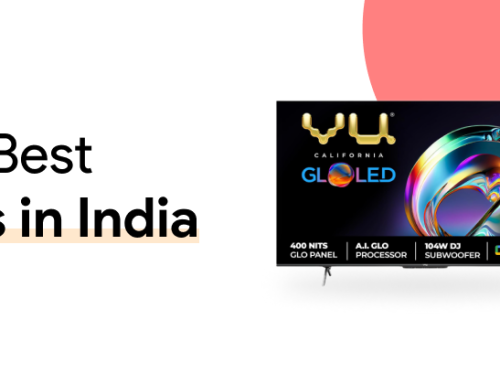Remember the time when we used to buy TVs based on their size? In the 2000s, there would be two options to choose from if you planned to buy a TV. You could either choose a monochrome TV or a coloured TV. The “dumb TVs” could only stream content from an antenna or other A/V sources.
With the technology evolving and improving, the size of TVs has increased. Their functionality has improved drastically. Now, every TV is a “Smart TV”.
I’ve talked about smart TVs, different screen display technologies, and the best brands on the market in this article. I’ve also covered tech jargon like OLED and LED, which can be confusing when shopping for a television. Let’s take a look at each of the topics one by one!
What are Smart TVs?
A smart TV combines the functions of a television, a media player, and a computer into one device. That means you can watch your Netflix show on a smart TV too! Or play your favourite music via Spotify. Smart TVs have internet access and can be wirelessly connected to other devices such as tablets or laptops. You can integrate a voice assistant like Google Assistant or Alexa into your smart TV.
Although all types of televisions are “smart,” the screen display technologies vary. The type of screen display on your TV is also important because it will improve your viewing experience. You can buy seven different types of TVs based on screen technology. The following are the details:
- Quantum Light Emitting Diode (QLED) TV
QLED TVs were first introduced by Sony in 2013. Samsung now offers the best QLED smart TVs on the market. Instead of using LEDs, quantum dots are tiny nanoparticles that produce images on the screen. They, like LED TVs, still require a backlight to illuminate the screen. Because of the technology, these smart TVs last longer but require larger screens. Because of the quantum dots, QLEDs have excellent brightness and contrast. Apart from Samsung, the following brands sell QLED TVs in India:
- OnePlus
- Sansui
- MI
- TCL
- Compaq
The price range is from 32k to 75k.
- Organic Light Emitting Diode (OLED) TV
As the name suggests, OLED uses organic materials like Carbon or polymers to display an image with the help of electric current. The display does not require a backlight. As a result, they can be flexible and thin because no filter layers are required. The image quality is arguably the best among OLEDs, with only QLEDs coming close. OLEDs can theoretically transmit images 1000 times faster than LCD TVs with 1000 Hz refresh rates. They use less power than other types of TVs because they don’t have backlighting.
Steven Van Slyke invented OLEDs in 2012. Since then, they’ve slowly been taking over the market of LCD TVs. They can be pricey due to their superior technology. The price range is typically from 80k to 2.50 lacs. The best OLED TV brands that you can find in India are
- LG
- Xiaomi
- Sony
The drawbacks that OLED TVs have is their short lifespan and screen burn-in.
- Light Emitting Diode (LED) TVs
LED televisions, which were first introduced in 2007, are still popular in India today. Instead of fluorescent bulbs, these TVs use light emitting diodes (LEDs) to display images on the screen (CCFLs). They use 20% less energy than LCD TVs and can be made thinner. The image quality is also superior to that of LCD televisions. LED televisions are divided into two categories:
- Edge-Lit LED TVs: They are the most affordable LED TVs. Despite having average and inconsistent picture quality, it is the lightest and thinnest LED TV when compared to direct-lit LED TVs.
- Direct-Lit LED TVs: LEDs directly behind the screen backlight the displays on these TVs. Colour accuracy, contrast, and brightness are all improved. Local dimming is also present, and it is thicker than edge-lit models.
LED TVs are significantly less expensive than the two types of smart TVs discussed above. The price ranges from $8,500 to $32,000. The best-LED TV manufacturers in India are
- Sony
- Xiaomi
- Samsung
- Panasonic
- OnePlus
- LG
- VU
- Liquid Crystal Display (LCD) TVs
LCD TVs have been in the market for decades. They use liquid crystals and fluorescent bulbs to display images on the screen. Newer models also use LEDs for displaying pictures and are called LED TVs. They are the best type of TV to use on outdoors. The downsides are that they consume immense power and have a lower colour gamut. The price range varies from 8k to 30k. There are hundreds of brands that provide LCD TVs. Brands that produce durable LCD TVs in India are
- Onida
- Croma
- LG
- Sony
- Panasonic
- MI
- Digital Light Processing (DLP) TVs
Texas instruments invented DLP TVs in the 80s to address the problem of the previous TV technologies. DLP TVs use a semiconductor chip called a digital micromirror device (DMD) to display images. The DMD uses millions of pixels which tilt in various directions and degrees to create pictures with electricity. They have 3D projection and are lightweight with a long lifespan. However, this model became obsolete in 2012 due to the introduction of better and advanced models.
- Plasma TVs
Plasma TVs are a type of flat screen TV that uses plasma to produce images. These types of TVs use an alternate technology to the cathode ray tube tech. The Plasma technology has a faster frame response than cathode ray tube tech (600 Hz). They have good brightness and a colour gamut. Plasma TVs have the best TV size for bedrooms since they have large screens (minimum being 40 inches) and different viewing angles. They weigh more than LCD TVs, consume a lot of power, have a short lifespan and have issues with screen burn-in or image retention.
Plasma TVs were available in the 2000s but went obsolete in 2015. Screen technologies like QLED and OLED have taken over their place.
- Cathode Ray Tube (CRT) or Direct TVs
CRT technology has been used to produce images on television screens since the 1930s. Due to low demand, manufacturers have stopped producing in recent years. Technology has improved as well.
The images on a CRT TV are smoother and crisper than those on other types of television. The monitors ranged in size from 19 to 43 inches. Direct TVs with screen sizes ranging from 19 to 25 inches were produced by the majority of manufacturers. Since old classic video games like Duck Hunt were specifically designed for CRT technology, these TVs are popular among gamers.
Direct TVs may not be prevalent now, but they may re-emerge as vintage and resurge.
Summary
All smart TVs provide high resolution (4k and 8k) and high definition image quality. But what technology it uses to display images matters. You may buy a LED TV with 4k resolution but it won’t be the same quality as an OLED or a QLED TV since each has advantages and disadvantages. So, you need to consider carefully before buying and consider how much you can afford and your other preferences.





Leave A Comment